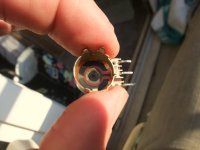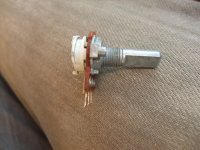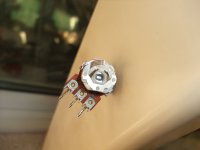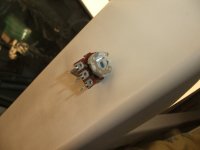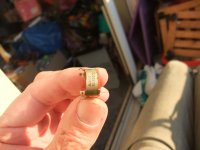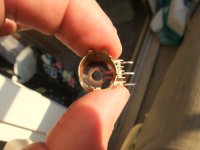By checking an integrated amplifier (Harman HK-610) I note crackling by rotation of the balance knob (usual on old amplifier stuff).
Upon closer inspection it turned out that this contact problems on this stereo potentiometer occurs only close to the center position.
It's about this part of Alps according SM: VR-501/502: Part-No 5113-S2005104, 100KΩ
After desolder and dismantling this part (because I assumed an internal deficiency due oxidation etc.),
I measure zero ohms from center tap to left and 100KΩ from center tap to right on slider track of first channel and the same, but vise versa on the second channel.
Thus only 135° usable angle of rotation is available.
On the first both attached jpg files the difference between one half of slider track surface and the other can also be seen visually.
I've never seen before this kind of slider track in balance pots - but it seems to have been widespread.
What is the correct naming of such potentiometers (without keyword I can't find information by google) ?
What benefits are to expect by using such versions for balance control in opposite to usual versions ?
Are ALPS datasheets of such kind of potentiometers available ?
Thank you very much for comments.
Upon closer inspection it turned out that this contact problems on this stereo potentiometer occurs only close to the center position.
It's about this part of Alps according SM: VR-501/502: Part-No 5113-S2005104, 100KΩ
After desolder and dismantling this part (because I assumed an internal deficiency due oxidation etc.),
I measure zero ohms from center tap to left and 100KΩ from center tap to right on slider track of first channel and the same, but vise versa on the second channel.
Thus only 135° usable angle of rotation is available.
On the first both attached jpg files the difference between one half of slider track surface and the other can also be seen visually.
I've never seen before this kind of slider track in balance pots - but it seems to have been widespread.
What is the correct naming of such potentiometers (without keyword I can't find information by google) ?
What benefits are to expect by using such versions for balance control in opposite to usual versions ?
Are ALPS datasheets of such kind of potentiometers available ?
Thank you very much for comments.
Attachments
Last edited:
Those are balance/blender pots with so-called MN taper (inverse "half linear" decks).
https://www.bourns.com/docs/ProAudioDocs/bourns_pdb182_blend-balance_guitar_pots_appnote.pdf
https://www.bourns.com/docs/Product-Datasheets/pdb182-gtrb.pdf

The idea, in use a balance control for HiFi, probably is to have no noise (or distortion) penalty in the center position.
https://www.bourns.com/docs/ProAudioDocs/bourns_pdb182_blend-balance_guitar_pots_appnote.pdf
https://www.bourns.com/docs/Product-Datasheets/pdb182-gtrb.pdf
The idea, in use a balance control for HiFi, probably is to have no noise (or distortion) penalty in the center position.
Good advice - thank you also for the URLs.
under
http://bee.mif.pg.gda.pl/ciasteczkowypotwor/#RTV/harmon_kardon_hk620.pdf
there isn't mentioned this keywords.
under
http://bee.mif.pg.gda.pl/ciasteczkowypotwor/#RTV/harmon_kardon_hk620.pdf
there isn't mentioned this keywords.
I've seen it first time on a Vestax DJ mixer.I've never seen before this kind of slider track in balance pots -
Due age of balance pots with MN taper there are more interrupts than with usual tapers (even after cleaning and remove oxidation) because In the center position a MN taper balance control is just wire.
So I can't find any particular advantages at first in favor of the MN taper. Under
https://sound-au.com/pots.htm
MN tapers aren't mentioned.
several details to MN and other different tapers:
https://web.archive.org/web/2020020...s.com/cd_catalog/new_catalogs/Pots/tapers.htm
https://www.eevblog.com/forum/beginners/mn-taper-poteniometer/
https://www.diyaudio.com/community/threads/balance-pot-wiring.400219/ (post #19)
https://www.diyaudio.com/community/threads/relative-impedance-of-balance-pot-to-volume-pot.294453/ (post #6)
P.S.: currently ALPS don't offer potentiometers with MN taper - go to
https://tech.alpsalpine.com/e/products/category/potentiometer/sub/01/series/rk163/
So I can't find any particular advantages at first in favor of the MN taper. Under
https://sound-au.com/pots.htm
MN tapers aren't mentioned.
several details to MN and other different tapers:
https://web.archive.org/web/2020020...s.com/cd_catalog/new_catalogs/Pots/tapers.htm
https://www.eevblog.com/forum/beginners/mn-taper-poteniometer/
https://www.diyaudio.com/community/threads/balance-pot-wiring.400219/ (post #19)
https://www.diyaudio.com/community/threads/relative-impedance-of-balance-pot-to-volume-pot.294453/ (post #6)
P.S.: currently ALPS don't offer potentiometers with MN taper - go to
https://tech.alpsalpine.com/e/products/category/potentiometer/sub/01/series/rk163/
Attachments
-
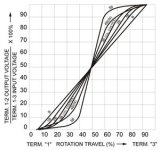 taper-b.jpg19 KB · Views: 60
taper-b.jpg19 KB · Views: 60 -
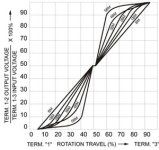 taper-b-w_tap.jpg20.6 KB · Views: 52
taper-b-w_tap.jpg20.6 KB · Views: 52 -
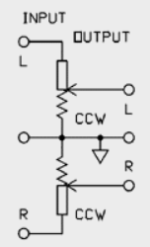 MN taper-II.png6.3 KB · Views: 84
MN taper-II.png6.3 KB · Views: 84 -
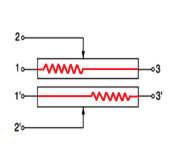 MN taper.png10.2 KB · Views: 75
MN taper.png10.2 KB · Views: 75 -
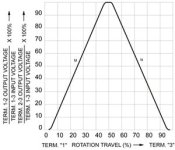 taper-m_n.jpg18 KB · Views: 64
taper-m_n.jpg18 KB · Views: 64 -
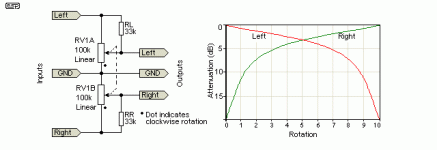 Balance control without MN taper.gif5.9 KB · Views: 68
Balance control without MN taper.gif5.9 KB · Views: 68 -
bourns_pdb182_blend_balance_gtr_pots_appnote_for_bass.pdf934.8 KB · Views: 77
-
anwendungsbeschreibung-blend-balance-potis-bourns-pdb182-für-gitarren.pdf493.8 KB · Views: 92
Last edited:
This is probably made this way because...... When you regulate/attenuate one channel, you want the other to be unaffected by the rotation/keeping
the 100K constant and vice versa. You would otherwise keep raising the potmeters impedance on the opposite channel, to the one
you´re trying to attenuate. Not that uncommon to see this type of balance control 😉
the 100K constant and vice versa. You would otherwise keep raising the potmeters impedance on the opposite channel, to the one
you´re trying to attenuate. Not that uncommon to see this type of balance control 😉
https://sound-au.com/project01.htm
5 - Better Balance Control ..............
Para 2:
Bear in mind that many (especially early Japanese) designs use a specially designed pot for balance, and these are not suitable for the circuits shown below. These pots commonly have a centre detent, and the resistance of each track remains very low from the centre position to one end (or the other) of travel. These 'special' pots are characterised by the level remaining constant in one channel or the other as the balance pot is moved. The overall law of these controls is (IMO) unsatisfactory for hi-fi.
5 - Better Balance Control ..............
Para 2:
Bear in mind that many (especially early Japanese) designs use a specially designed pot for balance, and these are not suitable for the circuits shown below. These pots commonly have a centre detent, and the resistance of each track remains very low from the centre position to one end (or the other) of travel. These 'special' pots are characterised by the level remaining constant in one channel or the other as the balance pot is moved. The overall law of these controls is (IMO) unsatisfactory for hi-fi.
- Home
- Design & Build
- Parts
- Balance Potentiometer with only 135° usable Angle of Rotation - what Benefit?
